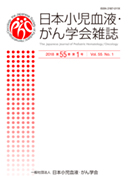Volume 58, Issue 3
Displaying 1-26 of 26 articles from this issue
- |<
- <
- 1
- >
- >|
The 60th Annual Meeting of the Japanese Society of Pediatric Hematology / Oncology
-
2021Volume 58Issue 3 Pages 185-193
Published: 2021
Released on J-STAGE: November 13, 2021
Download PDF (2294K)
The 62nd Annual Meeting of the Japanese Society of Pediatric Hematology / Oncology
-
2021Volume 58Issue 3 Pages 194-198
Published: 2021
Released on J-STAGE: November 13, 2021
Download PDF (1205K)
-
2021Volume 58Issue 3 Pages 199-207
Published: 2021
Released on J-STAGE: November 13, 2021
Download PDF (5507K)
-
2021Volume 58Issue 3 Pages 208-212
Published: 2021
Released on J-STAGE: November 13, 2021
Download PDF (1164K)
-
2021Volume 58Issue 3 Pages 213-214
Published: 2021
Released on J-STAGE: November 13, 2021
Download PDF (685K) -
2021Volume 58Issue 3 Pages 215-217
Published: 2021
Released on J-STAGE: November 13, 2021
Download PDF (725K)
-
2021Volume 58Issue 3 Pages 218-225
Published: 2021
Released on J-STAGE: November 13, 2021
Download PDF (2047K) -
2021Volume 58Issue 3 Pages 226-232
Published: 2021
Released on J-STAGE: November 13, 2021
Download PDF (847K) -
2021Volume 58Issue 3 Pages 233-239
Published: 2021
Released on J-STAGE: November 13, 2021
Download PDF (2430K) -
2021Volume 58Issue 3 Pages 240-244
Published: 2021
Released on J-STAGE: November 13, 2021
Download PDF (1379K)
-
2021Volume 58Issue 3 Pages 245-247
Published: 2021
Released on J-STAGE: November 13, 2021
Download PDF (720K)
-
2021Volume 58Issue 3 Pages 248-252
Published: 2021
Released on J-STAGE: November 13, 2021
Download PDF (776K)
Review Article
-
2021Volume 58Issue 3 Pages 253-262
Published: 2021
Released on J-STAGE: November 13, 2021
Download PDF (2023K)
Original Article
-
2021Volume 58Issue 3 Pages 263-268
Published: 2021
Released on J-STAGE: November 13, 2021
Download PDF (892K) -
2021Volume 58Issue 3 Pages 269-274
Published: 2021
Released on J-STAGE: November 13, 2021
Download PDF (786K) -
2021Volume 58Issue 3 Pages 275-282
Published: 2021
Released on J-STAGE: November 13, 2021
Download PDF (1035K)
Case Report
-
2021Volume 58Issue 3 Pages 283-286
Published: 2021
Released on J-STAGE: November 13, 2021
Download PDF (2487K) -
2021Volume 58Issue 3 Pages 287-291
Published: 2021
Released on J-STAGE: November 13, 2021
Download PDF (3379K) -
Pediatric malignant spinal cord compression and neurological prognosis: case series of four patients2021Volume 58Issue 3 Pages 292-295
Published: 2021
Released on J-STAGE: November 13, 2021
Download PDF (1611K) -
2021Volume 58Issue 3 Pages 296-300
Published: 2021
Released on J-STAGE: November 13, 2021
Download PDF (4485K) -
2021Volume 58Issue 3 Pages 301-305
Published: 2021
Released on J-STAGE: November 13, 2021
Download PDF (5481K) -
2021Volume 58Issue 3 Pages 306-310
Published: 2021
Released on J-STAGE: November 13, 2021
Download PDF (8107K) -
2021Volume 58Issue 3 Pages 311-314
Published: 2021
Released on J-STAGE: November 13, 2021
Download PDF (2932K) -
2021Volume 58Issue 3 Pages 315-319
Published: 2021
Released on J-STAGE: November 13, 2021
Download PDF (825K) -
2021Volume 58Issue 3 Pages 320-324
Published: 2021
Released on J-STAGE: November 13, 2021
Download PDF (2089K)
Report
-
2021Volume 58Issue 3 Pages 325-329
Published: 2021
Released on J-STAGE: November 13, 2021
Download PDF (7852K)
- |<
- <
- 1
- >
- >|
